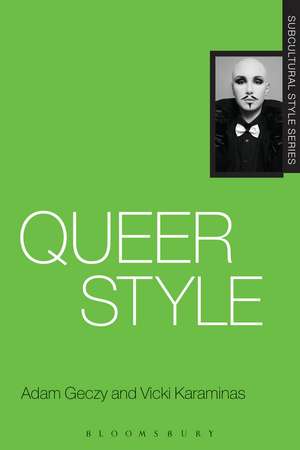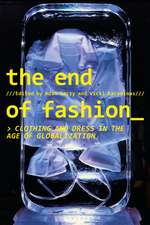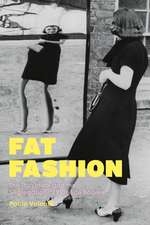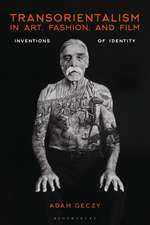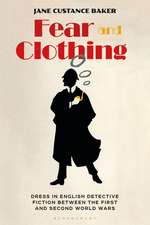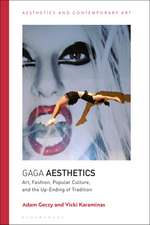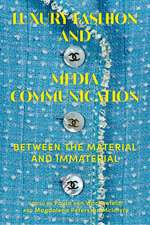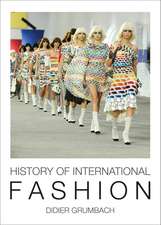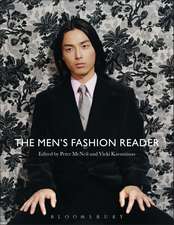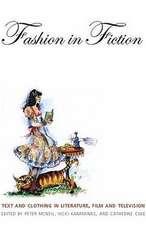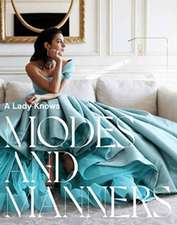Queer Style: Subcultural Style
Autor Adam Geczy, Vicki Karaminasen Limba Engleză Hardback – 14 aug 2013
| Toate formatele și edițiile | Preț | Express |
|---|---|---|
| Paperback (1) | 173.73 lei 3-5 săpt. | +56.00 lei 4-10 zile |
| Bloomsbury Publishing – 12 iun 2024 | 173.73 lei 3-5 săpt. | +56.00 lei 4-10 zile |
| Hardback (2) | 473.98 lei 3-5 săpt. | |
| Bloomsbury Publishing – 12 iun 2024 | 473.98 lei 3-5 săpt. | |
| Bloomsbury Publishing – 14 aug 2013 | 763.94 lei 6-8 săpt. |
Preț: 763.94 lei
Preț vechi: 839.50 lei
-9% Nou
Puncte Express: 1146
Preț estimativ în valută:
146.23€ • 158.89$ • 122.91£
146.23€ • 158.89$ • 122.91£
Carte tipărită la comandă
Livrare economică 22 aprilie-06 mai
Preluare comenzi: 021 569.72.76
Specificații
ISBN-13: 9781847881953
ISBN-10: 1847881955
Pagini: 208
Ilustrații: 19 bw illus
Dimensiuni: 156 x 234 x 14 mm
Greutate: 0.5 kg
Editura: Bloomsbury Publishing
Colecția Bloomsbury Academic
Seria Subcultural Style
Locul publicării:London, United Kingdom
ISBN-10: 1847881955
Pagini: 208
Ilustrații: 19 bw illus
Dimensiuni: 156 x 234 x 14 mm
Greutate: 0.5 kg
Editura: Bloomsbury Publishing
Colecția Bloomsbury Academic
Seria Subcultural Style
Locul publicării:London, United Kingdom
Caracteristici
Looks at a diverse range of dress including the effeminate 'pansy', the masculine macho 'clone', the 'lipstick' and 'butch' lesbian styles and extreme styles of drag kings and queens
Notă biografică
Adam Geczy is an artist and writer. He is Senior Lecturer at Sydney College of the Arts, Australia, and author of several books including (with Michael Carter) Reframing Art (Berg, 2005) and Art: Histories, Theories and Exceptions (Berg, 2008), a Choice Outstanding Academic Title, 2009.Vicki Karaminas is Associate Professor of Fashion Studies and Associate Head of the School of Design at the University of Technology, Sydney, Australia. She is the Executive Director and Chair of Fashion for the Popular Culture Association of Australia and New Zealand and the Chair for Subcultural Style and Identity for the Popular Culture and American Culture Associations. She is the editor of The Men's Fashion Reader (Berg, 2009), Fashion in Fiction (Berg, 2009) and The Australasian Journal of Popular Culture.
Cuprins
ContentsIntroductionChapter One: The Meaning of Style Between Classic and Queer Winckelmann and the Suppressed Homoerotism in Modernist style A Selective History of Non-queer, Standard, Straight and Classic dressingChapter Two: Lesbian Style: From Mannish Women to Lipstick Dykes Mannish Lesbians and Salon Dandies Lesbian Bar Culture of the Forties and Fifties Feminist Androgyny and Anti Style Cross Dressing and Androgynous Style Designer Dykes and Lesbian ChicChapter Three: Gay Men's Style: From Macaroni to Metrosexual Macaronis and Fops Dandies, Aesthetes, Oscar Wilde, and the Early Days of Queer Style The Artistic Avant-garde and the Years Pending World War II Artistic Bent. Warhol, Glam and Pop Gay Activism, Gay pride, Clowns and Clones Contemporary Queer: Hard to SayChapter Four: Kiss of the Whip. Bondage, Discipline and Sado-Masochism, or BDSM Style Military Uniforms and the Gestapo Clips, Clamps Leather and AccessoriesChapter Five: Drag. Of Kings and Queens Dames, Divas and Queens Drag Balls Kinging and Club CultureChapter Six: Crossing Genders, Crossing Cultures Japanese Dandy Style Mardi Gras Boys of Singapore Albanian Sworn Virgins Polynesian Gender Crossing The Hijra: An Alternative Gender Role in India Lady Boys and Tom Boys of ThailandConclusion: Against Justification
Recenzii
If clothes make the man (and the woman), how much more do they make the queer man or woman. This insightful book looks at the way fashion has coded same-sex desire, from eighteenth-century macaronis and gentlemen fops to modern leathermen and muscle queens, from mannish Sapphic women to lipstick lesbians. As those with homoerotic orientations constructed their sexualities and identities, the authors reveal, so they dressed themselves for the parts they played.
From Rosa Bonheur and Radclyffe Hall through Bowie and Warhol to Boy George and Leigh Bowery: just a few of the style icons present in this wide-ranging, illuminating and highly readable account of over two centuries of queer performance and posing.
This book provides a refreshingly engaging and extraordinarily superior standard ofscholarship that inquires analytically into complex LGBTQI issues and challenges &complements the works of Bultler, Foucault, Halberstam, Shapiro and others in the field.Their work will contribute to original scholarship on LGBTQI in a number of related ways.This text further gives voice to the many LGBTQI communities of actors and displays ascholarly trajectory that is not only well-grounded but combines the best traditions oftheoretical and methodological triangulation.
This book is impressive in rigor, scope and scholarship. It assembles iconic stylish and fashionable gay, lesbian, transgendered and queer characters such as: dandies and dykes, leather-boys and lipstick lesbians. While, there has been a tremendous amount of writing in queer studies, none has combined it with fashion and style to give us a fresh look at fashion studies. With panache and humor, this much-anticipated text is the first extensive analysis of both fashion scholarship and queer theory - it undoubtedly is destined to become a classic.
Much of what counts as queer theory now, and in recent years, has danced around the question of style. Is style the name for a self-fashioning that marks the emergence of self-consciously gay and lesbian populations around the beginning of the twentieth century? Or is style a recognizable form of gay, lesbian and transgender narrative, readable on bodies and texts alike? Is style a mode of being and becoming that both disrupts chronological histories of sexuality and confirms them all at once? The answer given by this fresh, new volume on the subject is yes, yes, and yes. As to whether you can wear white shoes after summer's end, blue and green together or a meat dress to the Oscars.you are on your own.
This is an extremely important book. The subject of GLBTQ fashion and style has been sadly neglected and this book marks a clear redresseing of that neglect. Queer Style is a well researched and eloquently written book that fills a massive gap in the current writing on this important area of fashion, dress and identity. The subject matter covered in this book is a much neglected area of study and Geczy and Karaminas's complementary backgrounds and areas of interest provide a much needed and long overdue articulate contribution to the area. The depth of research as well the global aspects of the book make this an invaluable text for accomplished scholars and to students from a range of academic courses. I thoroughly recommend this book.
From Rosa Bonheur and Radclyffe Hall through Bowie and Warhol to Boy George and Leigh Bowery: just a few of the style icons present in this wide-ranging, illuminating and highly readable account of over two centuries of queer performance and posing.
This book provides a refreshingly engaging and extraordinarily superior standard ofscholarship that inquires analytically into complex LGBTQI issues and challenges &complements the works of Bultler, Foucault, Halberstam, Shapiro and others in the field.Their work will contribute to original scholarship on LGBTQI in a number of related ways.This text further gives voice to the many LGBTQI communities of actors and displays ascholarly trajectory that is not only well-grounded but combines the best traditions oftheoretical and methodological triangulation.
This book is impressive in rigor, scope and scholarship. It assembles iconic stylish and fashionable gay, lesbian, transgendered and queer characters such as: dandies and dykes, leather-boys and lipstick lesbians. While, there has been a tremendous amount of writing in queer studies, none has combined it with fashion and style to give us a fresh look at fashion studies. With panache and humor, this much-anticipated text is the first extensive analysis of both fashion scholarship and queer theory - it undoubtedly is destined to become a classic.
Much of what counts as queer theory now, and in recent years, has danced around the question of style. Is style the name for a self-fashioning that marks the emergence of self-consciously gay and lesbian populations around the beginning of the twentieth century? Or is style a recognizable form of gay, lesbian and transgender narrative, readable on bodies and texts alike? Is style a mode of being and becoming that both disrupts chronological histories of sexuality and confirms them all at once? The answer given by this fresh, new volume on the subject is yes, yes, and yes. As to whether you can wear white shoes after summer's end, blue and green together or a meat dress to the Oscars.you are on your own.
This is an extremely important book. The subject of GLBTQ fashion and style has been sadly neglected and this book marks a clear redresseing of that neglect. Queer Style is a well researched and eloquently written book that fills a massive gap in the current writing on this important area of fashion, dress and identity. The subject matter covered in this book is a much neglected area of study and Geczy and Karaminas's complementary backgrounds and areas of interest provide a much needed and long overdue articulate contribution to the area. The depth of research as well the global aspects of the book make this an invaluable text for accomplished scholars and to students from a range of academic courses. I thoroughly recommend this book.
Descriere
Offers an account of queer fashionability in historical as well as contemporary lifestyles.
